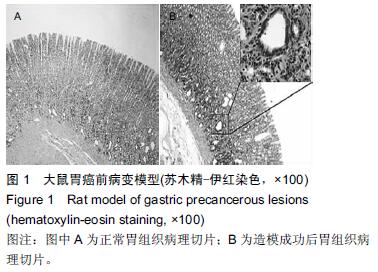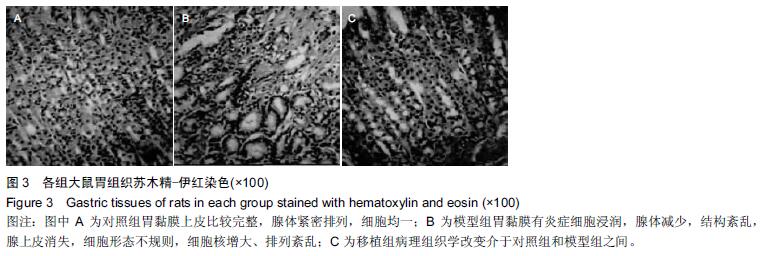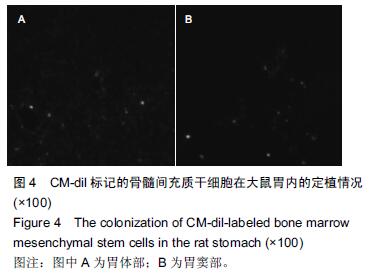| [1] 陈万青,郑荣寿,张思维,等. 2003~2007年中国癌症发病分析[J].中国肿瘤,2012,21(3):161-170. [2] 胡建平,张铁英,马彬,等.亚甲蓝染色对胃癌前病变的诊断价值[J]. 胃肠病学和肝病学杂志,2010,19(3):219-221. [3] 王珏,刘邦伦,易楠,等.血清胃蛋白酶原检测结合美蓝-靛胭脂双重染色法对胃癌及胃癌前病变的诊断价值[J].重庆医科大学学报,2011,36(9):1084-1086. [4] 张静洁,孟宪梅,党彤,等. 胃小凹形态及微血管变化联合PCNA、p53检测在胃癌前病变诊断中的应用[J].山东医药,2013,53(30):9-12. [5] 李春英,梁爱华,高双荣,等.大鼠胃癌前病变模型的建立[J].中国中药杂志,2012,37(1):89-93. [6] 魏玥,杨晋翔,李志刚,等. N-甲基-N'-硝基-N-亚硝基胍胃癌前病变大鼠造模联合因素的探讨[J].中西医结合消化杂志,2011,19(2):111-112. [7] 谢晶日,王业莉,张扬,等.复合造模法建立大鼠胃癌前病变模型的实验研究[J].中华中医药学刊,2013,31(11): 2341-2343. [8] 马伟明,陈笑腾,康年松,等.红藤愈萎养胃汤对胃癌前病变血清胃癌相关抗原MG7、胃蛋白酶原表达的影响[J].中华中医药学刊,2012,30(1):70-72. [9] 李伟,赵卫东,张威庆,等.COX-2和CK20在胃癌前病变、胃癌黏膜组织中的表达及临床意义[J].山东医药,2012, 52(7):69-71. [10] 苏秀丽,金建军. Rb与C-erbB-2基因在胃癌前病变组织中的表达及其临床病理意义[J].河南科技大学学报:医学版, 2012,30(2):87-89. [11] 张小艳,王曙升,宋瑛,等. IL-10、iNOS在幽门螺旋杆菌相关性胃炎及胃癌前病变组织中表达的相关性研究[J].现代肿瘤医学,2013,21(8):1830-1833. [12] 王建斌.半夏泻心汤加味治疗胃癌前病变27例[J].西部中医药,2011,24(12):45-48. [13] 杜艳茹,李佃贵,王春浩,等.化浊解毒方治疗慢性萎缩性胃炎胃癌前病变浊毒内蕴证患者119例临床观察[J].中医杂志,2012,53(1):31-33,37. [14] Pittenger MF, Mackay AM, Beck SC,et al. Multilineage potential of adult human mesenchymal stem cells. Science. 1999;284(5411):143-147. [15] Danielyan L, Schäfer R, von Ameln-Mayerhofer A, et al.Therapeutic efficacy of intranasally delivered mesenchymal stem cells in a rat model of Parkinson disease.Rejuvenation Res. 2011;14(1):3-16. [16] Tolar J, Villeneuve P, Keating A.Mesenchymal stromal cells for graft-versus-host disease.Hum Gene Ther. 2011;22(3):257-262. [17] 王丽娟,张媛媛.骨髓间充质干细胞的研究进展[J].赤峰学院学报:自然科学版,2010,26(3):70-72. [18] 韩娜,寇玉辉,王天兵,等.17β-雌二醇对大鼠骨髓间充质干细胞向成骨细胞分化的诱导调控[J].中国组织工程研究,2012,16(10):1721-1724. [19] 赵大成,汪玉良,党跃修,等.大鼠骨髓间充质干细胞的体外成骨诱导[J].中国组织工程研究,2012,16(14):2491- 2495. [20] Pérez-Ilzarbe M, Díez-Campelo M, Aranda P,et al. Comparison of ex vivo expansion culture conditions of mesenchymal stem cells for human cell therapy. Transfusion. 2009;49(9):1901-1910. [21] Chen LB, Jiang XB, Yang L.Differentiation of rat marrow mesenchymal stem cells into pancreatic islet beta- cells.World J Gastroenterol. 2004;10(20):3016- 3020. [22] 章培军,张丽红,郭敏芳.骨髓间充质干细胞体外诱导分化为心肌样细胞[J].实用医学杂志,2010,26(6):957-959. [23] Oh SH, Miyazaki M, Kouchi H, et al.Hepatocyte growth factor induces differentiation of adult rat bone marrow cells into a hepatocyte lineage in vitro.Biochem Biophys Res Commun. 2000;279(2):500-504. [24] Komori M, Tsuji S, Tsujii M,et al.Efficiency of bone marrow-derived cells in regeneration of the stomach after induction of ethanol-induced ulcers in rats.J Gastroenterol. 2005;40(6):591-599. [25] Chang Q, Yan L, Wang CZ, et al.In vivo transplantation of bone marrow mesenchymal stem cells accelerates repair of injured gastric mucosa in rats.Chin Med J (Engl). 2012;125(6):1169-1174. [26] Worthley DL, Ruszkiewicz A, Davies R,et al.Human gastrointestinal neoplasia-associated myofibroblasts can develop from bone marrow-derived cells following allogeneic stem cell transplantation.Stem Cells. 2009; 27(6):1463-1468. [27] Otsu K, Das S, Houser SD,et al.Concentration- dependent inhibition of angiogenesis by mesenchymal stem cells.Blood. 2009;113(18):4197-4205. [28] Lu YR, Yuan Y, Wang XJ,et al.The growth inhibitory effect of mesenchymal stem cells on tumor cells in vitro and in vivo.Cancer Biol Ther. 2008;7(2):245-251. [29] Tanaka F, Tominaga K, Ochi M, et al. Exogenous administration of mesenchymal stem cells ameliorates dextran sulfate sodium-induced colitis via anti-inflammatory action in damaged tissue in rats.Life Sci. 2008;83(23-24):771-779. [30] 钟晓红,王明刚,赵李平,等.骨髓间充质干细胞在糖尿病模型创面中向表皮细胞分化的初步研究[J].中国美容医学, 2010,19(1):65-67. [31] Tanaka H, Arimura Y, Yabana T,et al. Myogenic lineage differentiated mesenchymal stem cells enhance recovery from dextran sulfate sodium-induced colitis in the rat.J Gastroenterol. 2011;46(2):143-152. [32] Deans RJ, Moseley AB.Mesenchymal stem cells: biology and potential clinical uses.Exp Hematol. 2000; 28(8):875-884. [33] Maruyama T, Kono K, Mizukami Y,et al.Distribution of Th17 cells and FoxP3(+) regulatory T cells in tumor-infiltrating lymphocytes, tumor-draining lymph nodes and peripheral blood lymphocytes in patients with gastric cancer.Cancer Sci. 2010;101(9): 1947-1954. [34] Wang SS, Asfaha S, Okumura T, et al. Fibroblastic colony-forming unit bone marrow cells delay progression to gastric dysplasia in a helicobacter model of gastric tumorigenesis.Stem Cells. 2009: 27(9):2301-2311. |
.jpg)





.jpg)